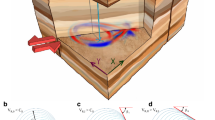Abstract
In this paper, mantle circulation flow, continental drift, earthquake origin and other mechanical principles are examined as they apply to earthquake engineering, seismology and dynamics of fluid saturated porous medium. The relationship of mantle flow to earthquakes is examined and clarified, and a new model, different from Haskell’s, is proposed for the earthquake mechanism. The proposed new model is based on the discovery that two pairs of jump stress and jump velocity will start to act from the fault plane. Records obtained directly from recent earthquakes nearby and right on the fault break show a very large velocity impulse, which verify, indirectly, the new mechanism proposed by the author. Further, at least two physical parameters that characterize the seismic intensity must be specified, because according to the discontinuous (jump) wave theory, at the earthquake source, the stress jump and the velocity jump of particle motion should act simultaneously when a sudden break occurs. The third key parameter is shown to be the break (fracture) propagation speed together with the break plane area. This parameter influences the form of the unloading time function at the source. The maximum seismic stress in and displacement of a building are estimated for two unfavorable combinations of the building and its base ground in terms of their relative rigidity. Finally, it is shown that Biot’s theory of wave propagation in fluid saturated porous media is valid only when fluid flow cannot occur.
Similar content being viewed by others
References
Biot MA (1956), “Theory of Propagation of Elastic Waves in a Fluid-saturated Porous Solid,” J. Acoust. Soc. Amer., 28(2).
Biot MA (1962), “Mechanics of Deformation and Acoustic Propagation in Porous Media,” J. Appl. Phys., 33(4).
Elnashia AS (1996), “Significance of Vertical Earthquake Motion for RC Buildings,” Structural Dynamics, Proc. EURODYN 96, Florence, 1, pp.129–136.
Haskell NA (1964) “Total Energy and Energy Spectral Density of Elastic Wave Radiation from Propagating Faults,” BSSA, 54: 1811.
Jeffrey A (1964), Non-linear Wave Propagation with Applications to Physics and Magneto-Hydrodynamics, McGraw-Hill.
Jennings Paul C (2000), “Ground Motion Pulses and Structural Responses,” Proc. Earthq. Eng. Frontiers in New Millen., Beijing, China.
Li Siguang (1977), On Earthquake (in Chinese), Geology Press, Beijing, China.
Men Fulu (1965), “Wave Propagation in Fluid-saturated Porous Elastic Media,” Acta Geophysica Sinica, 14(2).
Men Fulu (1981), “Wave Propagation in Fluid-saturated Porous Media,” Acta Geophysica Sinica, 24(1).
Men Fulu (1982), “On Wave Propagation in Fluid-saturated Porous Media,” Proc. Int. Conf.Earthq. Eng. And Soil Dyn., Vol.2., Sourthampton.
Men Fulu (1984) “One-dimensional Wave Propagation in Fluid-saturated Porous Elastic Media,” Acta Mathematica Scientia, 4(2): 467–476.
Men Fulu (1985), “Oscillation of Elasto-viscous Maxwell Fluid in Pipelines or Between Structural Space,” Fluid-Structure Dynamics, ASME, PVP-Vol.98-7, pp. 241–247.
Men Fulu et al. (1992) “Effects of Saturated-soil Layers on Seismic Wave Propagation,” Acta Geophysica Sinica, 35(4):521–532.
Men Fulu and Cui Jie (1995) “Effect of Alternate Dry and Saturated Soil Layers on Ground Motion and Wave Propagation,” Acta Geophysica Sinica, 38(6): 774–787.
Men Fulu and Cui Jie (1996), “A Simplified Reasoning of Rigidity Effect of Foundation Soil on Seismic Damage to Building,” Proc. 11th WCEE.
Men Fulu et al. (1998), “Estimation of Earthquake Mechanism on Ground Motion and Wave Propagation,” Proc. 11th ECEE, Paris.
Men Fulu (2000) “Earthquake Mechanism and its Effect on Ground Motion and Wave Propagation,” Chinese J. Geotech. Eng., 22(1):113–122.
Perzyna P (1959), “Stress Waves in a Homogeneous Elastic-visco-plastic Medium,” Arch. Mech. Stos. (11): 441–473.
Roy Arabinda (1965) “On the General Solution of Elastic Wave Equations in a Homogeneous Medium with Application to the Study of Earthquake Source Mechanisms,” BSSA, 55(2): 283–301.
TokuJi Utsu (1987). Dictionary of Major Things Related to Earthquake (in Japanese), Asamasa Press.
Tsien HS (1961), “On the Basic Equations of Soil Dynamics,” Problem of Continuum Mechanics.
Author information
Authors and Affiliations
Corresponding author
Rights and permissions
About this article
Cite this article
Men, F. Investigation of earthquake mechanisms and their impact on certain basic concepts in earthquake engineering and seismology. Earthq. Engin. Engin. Vib. 1, 281–291 (2002). https://doi.org/10.1007/s11803-002-0073-2
Issue Date:
DOI: https://doi.org/10.1007/s11803-002-0073-2




